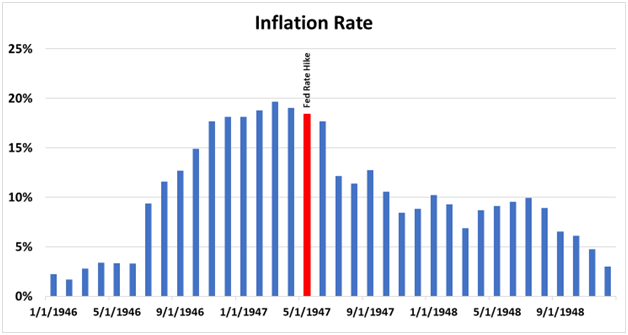The Federal Reserve faced a crossroads in tackling the rising inflation—it was either raising the interest rates earlier during the economic recovery, which would prevent a 2021 rebound, or hiking the interest rates aggressively as soon as it recognized inflation wasn’t “transitory.” Today’s FA Alpha Daily will examine how the Fed addressed the inflation of 1947 when the U.S. experienced similar rampant inflation, and how the stock market responded.
FA Alpha Daily:
Monday Macro
Powered by Valens Research
Over the past year, the Fed has been trapped between a rock and a hard place.
If the Federal Open Market Committee (“FOMC”) had raised rates earlier in our economic recovery, we might not have seen such a strong rebound in 2021. It started rate hikes in early 2022, as soon as it recognized inflation wasn’t “transitory.”
Now, of course, the central bank is hiking rates aggressively. It already raised rates by 1.5%, with at least another 0.75% increase likely this month. The Fed is clearly communicating to the market that it doesn’t want current inflation levels to become permanent.
It waited until the economy was on firmer footing in 2021. The moment it saw things were working on their own, it got aggressive against inflation.
This environment reminds us of the mid-1946 when America experienced similar rampant inflation. Back then, even more so than now, the Fed waited as long as possible to raise rates… until inflation had been burning hot for roughly a year.
As we mentioned last week, when inflation started to pick up, the stock market tanked. But the moment the Fed showed it was interested in fighting inflation, the freefall stopped. Stocks traded mostly sideways for the next year…

When the Fed finally intervened in 1947, it used multiple tools.
Three-month U.S. Treasury rates were raised from 0.37% to 1%. The central bank also raised the amount of money banks need to keep with the Fed through the federal funds rate.
The Fed hoped this would be enough to cool things down. And it was right.
Inflation started dropping immediately. The Consumer Price Index fell from 17.7% in June 1947 to less than 9% by that November. A year later, in November 1948, that number was below 5%. The Fed’s actions cut inflation by more than two-thirds from its peak.

It wasn’t just the market that listened to the Fed’s moves. Actual realized inflation responded as well.
The Fed is following that playbook again this time around, only executing on it faster.
Today’s central bank took action just a few quarters after inflation rates hit the mid-single digits. It didn’t wait for a year of 20% inflation.
And similar to last time, it’s using both interest rates and another tool in its arsenal.
Interest rates are already up significantly. As we mentioned, the Fed raised rates from a range of 0% to 0.25% in 2021 to a range of 1.5% to 1.75% today. It’s targeting a peak of 3.25% to 3.5%.
The Fed hasn’t adjusted reserve requirements this time to tighten standards.
It’s no longer buying bonds (also called “quantitative easing”) through mid-2021. Instead, it’s embracing quantitative tightening.
The Fed isn’t just raising rates. It’s running down its balance sheet, taking liquidity out of the system.
Thanks to all this, the three-month U.S. Treasury rate currently sits at more than 2.4%. That’s a far cry from a year ago when it was about 0.5%. And it’s double the move we saw in 1947.
The Fed’s 75-basis-point bump last month seems to have stabilized things. Two days after that June FOMC meeting, the market put in its low thus far. Since then, it’s up more than 7%.
The market has started to believe that the Fed is serious about stamping out inflation. But it’s also wondering if the Fed will be too successful in cooling down the economy.
Next week, we’ll discuss how the higher rates to curb inflation impacted the economy in the late 1940s.
Best regards,
Joel Litman & Rob Spivey
Chief Investment Strategist &
Director of Research
at Valens Research
To see our best macro insights, get access to FA Alpha Pulse.


